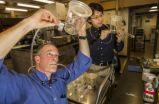(Press-News.org) Research published in Diabetologia (the journal of the European Association for the Study of Diabetes) suggests that two large meals (breakfast and lunch), rather than six small meals with the same total calories, are better for controlling weight and blood sugar in people with type 2 diabetes. The research is by Dr Hana Kahleová, Diabetes Centre, Institute for Clinical and Experimental Medicine, Prague, Czech Republic, and colleagues.
The study assessed 54 patients (29 men, 25 women) treated with oral diabetes drugs, aged 30–70 years, BMI 27–50 kg/m2 and HbA1c of 6–11.8% (42–105 mmol/mol). They were asked to follow one of two regimens of a restricted calorie diet, each containing 500 calories less than the recommended daily amount; in one programme the meals were six small meals (A6) and the other 2 large meals, breakfast and lunch (B2). In this cross-over trial, the 54 participants were divided into 2 groups of 27, with each group doing one of the two programmes for 12 weeks, and then after finishing moving on to the other programme, again for 12 weeks. The diet in both regimens had the same macronutrient and calorie content. Liver fat content, insulin sensitivity and pancreatic beta cell function (the cells that produce insulin) were measured using a variety of techniques and mathematical modelling.
The researchers found that body weight decreased in both regimens, more for B2 (-3.7kg) than for A6 (-2.3kg). Liver fat content decreased in response to both regimens, more for B2 (-0.04%) than for A6 (-0.03%). Fasting plasma glucose and C-peptide* levels decreased in both regimens, again more for B2. Fasting plasma glucagon (the hormone that converts glycogen back to glucose) decreased with the B2 regimen, whereas it increased for the A6 regimen. Oral glucose insulin sensitivity (OGIS) increased in both regimens, more for B2. No adverse events were observed for either regimen.
The authors say: "Eating only breakfast and lunch reduced body weight, liver fat content, fasting plasma glucose, C-peptide and glucagon, and increased OGIS, more than the same caloric restriction split into six meals. These results suggest that, for type 2 diabetic patients on a calorie-restricted diet, eating larger breakfasts and lunches may be more beneficial than six smaller meals during the day."
They add: "Novel therapeutic strategies should incorporate not only the energy and macronutrient content but also the frequency and timing of food. Further larger scale, long-term studies are essential before offering recommendations in terms of meal frequency."
INFORMATION: END
Two large meals (breakfast and lunch) better than 6 small meals with same calories for controlling weight and blood sugar in people with type 2 diabetes
2014-05-16
ELSE PRESS RELEASES FROM THIS DATE:
Complex interactions may matter most for longevity
2014-05-16
PROVIDENCE, R.I. [Brown University] — If studying a single gene or a diet that might extend longevity is like searching for a fountain of youth, then a new study calls for looking at something more like the whole watershed. Brown University biologists who experimentally throttled three such factors in fruit flies found that lifespan depended more on interactions among the factors than on the factors themselves.
"I think the main lesson is that these interaction effects are as significant or important as the [single] effects, such as diet effects alone or genetic effect ...
How some trypanosomes cause sleeping sickness while others don't
2014-05-16
Trypanosome parasites transmitted by tsetse flies cause devastating diseases in humans and livestock. Different subspecies infect different hosts: Trypanosoma brucei brucei infects cattle but is non-infectious to humans, whereas T. b. gambiense and T. b. rhodesiense cause sleeping sickness in humans. A study published on May 15th in PLOS Pathogens reveals how humans can fight off some trypanosomes but not others.
Sam Alsford, from the London School of Hygiene and Tropical Medicine, UK, and colleagues, undertook a comprehensive search for genes that make T. b. brucei ...
Walking may have profound benefits for patients with kidney disease
2014-05-16
Washington, DC (May 15, 2014) — For individuals with kidney disease, walking may help prolong life and reduce the risk of needing dialysis or a kidney transplant. That's the conclusion of a study appearing in an upcoming issue of the Clinical Journal of the American Society of Nephrology (CJASN).
Physical inactivity is common among patients with chronic kidney disease (CKD). Che-Yi Chou MD, PhD, Chiz-Tzung Chang, PhD (China Medical University Hospital, in Taiwan) and their colleagues looked to see if an activity as simple as walking might provide benefits to patients. ...
New tool to grow cancer cells streamlines laboratory research
2014-05-16
VIDEO:
Georgetown Lombardi Comprehensive Cancer Center researcher Anna T. Riegel, PhD, discusses a new technique that allows the growth of both normal and cancer cells and keeps them alive indefinitely is...
Click here for more information.
WASHINGTON — A new technique that allows the growth of both normal and cancer cells and keeps them alive indefinitely is transforming and expediting basic cancer research, say investigators from Georgetown Lombardi Comprehensive Cancer Center. ...
New kidney allocation policy could improve the success of transplantations in the US
2014-05-16
Washington, DC (May 15, 2014) — A newly approved US policy regarding allocation of kidneys from deceased donors will likely improve patient and transplant survival, according to a study appearing in an upcoming issue of the Journal of the American Society of Nephrology (JASN). The true effects of the new policy are yet to be seen, however, and officials will evaluate its intended and unintended consequences on an ongoing basis.
In 2013, the Organ Procurement and Transplantation Network in the United States approved a new national deceased donor kidney allocation policy ...
Novel genetic mechanism protects plants from toxic zinc
2014-05-16
Zinc is essential for optimal plant growth and development but when high levels of the metal are present in the soil, it can become toxic to the plant. Consequently, plants need to trigger mechanisms capable of coping with that stress. Researchers from the Instituto Gulbenkian de Ciência (IGC) have now discovered a novel genetic mechanism that protects plants from toxic zinc levels. The research team, led by Paula Duque, identified a gene that produces a protein capable of sequestering zinc inside the cells of the root. In the presence of high levels of zinc, this gene ...
Tumor cells in the blood may indicate poor prognosis in early breast cancer
2014-05-15
Tumor cells in bone marrow of early breast cancer patients predict a higher risk of relapse as well as poorer survival, but bone marrow biopsy is an invasive and painful procedure. Now, it may be possible to identify tumor cells in a routine blood sample and use them as prognostic markers, according to a study published May 15 in the Journal of the National Cancer Institute.
To assess the prognostic value of circulating tumor cells (CTCs) in patients with early breast cancer, Brigitte Rack, M.D., of the Department of Gynecology and Obstetrics, Klinikum Innenstadt, ...
Older migraine sufferers may have more silent brain injury
2014-05-15
DALLAS, May 15, 2014 — Older migraine sufferers may be more likely to have silent brain injury, according to research published in the American Heart Association’s journal Stroke.
In a new study, people with a history of migraine headaches had double the odds of ischemic silent brain infarction compared to people who said they didn’t have migraines. Silent brain infarction is a brain injury likely caused by a blood clot interrupting blood flow to brain tissue. Sometimes called “silent strokes,” these injuries are symptomless and are a risk factor for future strokes.
Previous ...
Study -- overweight teens more likely to be rejected as friends by normal weight peers
2014-05-15
Tempe, Ariz. (May, 15, 2014) - Overweight young people are more likely to be rejected as friends by peers who are of normal weight, according to new research by Arizona State University social scientists.
"Using Social Network Analysis to Clarify the Role of Obesity in Adolescent Friend Selection," published in the American Journal of Public Health by Arizona State University Associate Professors David R. Schaefer of the School of Human Evolution and Social Change and Sandra D. Simpkins of the T. Denny Sanford School of Social and Family Dynamics, used social network ...
2 JAMA Ophthalmology studies focus on glaucoma medication adherence
2014-05-15
Electronic monitoring to measure medication adherence by patients with glaucoma documented that a sizable number of patients did not regularly use the eye drops prescribed to them.
Topical medications for glaucoma lower intraocular pressure and can delay or slow the progression of the eye disease. Medication adherence is important.
Patients who were treated with once-daily prostaglandin eye drops were recruited from a university-based glaucoma clinic. Patients were given a container with an electronic cap in which to store their eye drops. The cap recorded each ...


